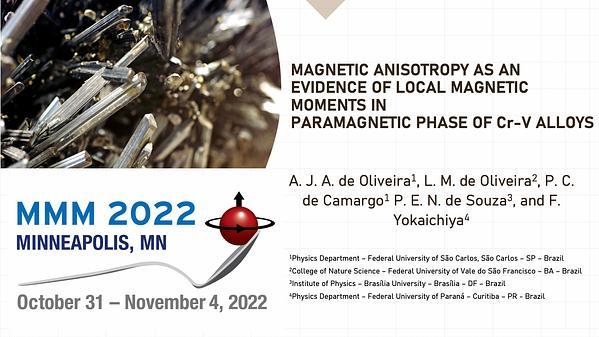Would you like to see your presentation here, made available to a global audience of researchers?
Add your own presentation or have us affordably record your next conference.
Manganites are one of the promising materials due to their great diversity in physical properties 1-4. These properties can be tuned by varying probability occupancy as well as ionic size of A-site cations, such as long range ordering observed in RBaMn2O6 (R=Rare earth ions) can be suppressed by cationic disorder 5-6. We made a comparative study of structure, magnetic (M) properties and magneto-resistance (MR) in A-site ordered NdBaMn2O6 (O-NB) and A-site disordered NdBaMn2O6 (D-NB), NdCaMn2O6 (D-NC). Experimental results from T dependent synchrotron PXRD (fig.1.a-c) concluded that structural symmetry strongly depends on A-site cationic distribution and their ionic sizes resulting in intriguing magnetic ground states. Moreover, MR (fig.2) is considerably large in disordered systems as compared to ordered one. Refinement of PXRD data showed that the A-site cations (Nd3+ & Ba2+) are completely ordered in O-NB. Lowering the T is accompanied with structural transition (ST) (fig.1.a) to lower space group. Whereas, there is no ST in disorder system, D-NB down to 120K. However, ST has been restored again in D-NC disordered system due to similar A-site cationic sizes, Nd3+ and Ca2+ ions. At the same time, M-T data show AFM ground state due to lower structural symmetry in O-NB and the ground state becomes FM in case of D-NB system due to the retainment of higher symmetric structure upto lowest T. Interestingly, AFM state has been restored in D-NC similar to that of O-NB due to presence of cationic disorder of similar sizes (fig.1.d-f). So, it can be argued that crystal structure and magnetic degrees of freedoms are strongly correlated with each other. Further, MR studies depict 3 times higher value of MR in both disorder compounds to that of order one (fig.2). However, behaviour of MR with H is different for D-NB and D-NC implying a different origin of this large MR in these compounds. We believe that the presence of phase separation in D-NC and AFM fluctuation in D-NB might be possible origin of their large MR with respect to O-NB system.
References
1 V.N. Smolyaninova, S.E. Lofland, C. Hill , R.C. Budhani, Z. Serpil Gonen, B.W. Eichhorn, and R.L. Green, Effect of A-site cation disorder on charge ordering and ferromagnetism of La0.5Ca0.5-yBayMnO3, J. Magn. Magn. Mater.248 (2002) 348.
2 T. Nakajima, H. Kageyama, H. Yoshizawa, K. Ohoyama, and Y. Ueda, Ground State Properties of the A-site Ordered Manganites, RBaMn2O6 (R = La, Pr and Nd), J. Phys. Soc. Jpn. 72 (2003) 3237.
3 J. Blasco, G. Subías, M. L. Sanjuán, J. L. García-Muñoz, F. Fauth, and J. García, Structure and phase transitions in A-site ordered RBaMn2O6 (R=Pr,Nd) perovskites with a polar ground state, Phys. Rev. B 103 (2021), 064105.
4 S. Yamada, H. Sagayama, K. Higuchi, T. Sasaki, K. Sugimoto, and T. Arima, Physical properties and crystal structure analysis of double-perovskite NdBaMn2O6 by using single crystals, Phys. Rev. B 95 (2017) 035101.
5 D. Akahoshi, M. Uchida, Y. Tomioka, T. Arima, Y. Matsui, and Y. Tokura, Random Potential Effect near the Bicritical Region in Perovskite Manganites as Revealed by Comparison with the Ordered Perovskite Analogs, Phys. Rev. Lett. 90 (2003) 177203.
6 T. Nakajima, H. Yoshizawa, and Y. Ueda, A-site Randomness Effect on Structural and Physical Properties of Ba-based Perovskite Manganites, J. Phys. Soc. Jpn. 73 (2004) 2283.


